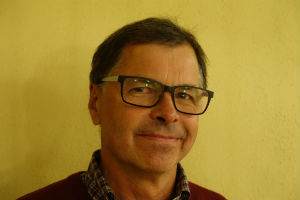Christer Bergsten

Presentation
Technical system in animal production with special interest in animal welfare and animal health related to animal environment and management systems
Teaching
Animal welfare in husbandry management system with special interest in flooring and lameness.
Teaching and supervision in programs at SLU: Animal science, Veterinary medicine, Ethology and Animal welfare, Agricultural and Rural Management, TUVE etc.
Also engaged in the claw trimmer education at BYS, continuing education of veterinarians, claw trimmers, farmers, and certification of claw trimmers
Research
- With an appreciated animal welfare research grant from FORMAS and together with Lund University we are going to develop a system of "Continuous surveillance of animal welfare in housed dairy cows using image analysis technology". The 3 years project aims to answer the question "How are animals doing "? The project aims to identify biomarkers of animal health and welfare in order to increase knowledge of animal behavior and basic needs in general, and the importance of locomotion disorders in particular. We want to examine how dairy cows adapt their behavior in newly developed automatic management systems in order to detect animal abnormalities that can lead to compromised welfare and health. Image analysis means that the herd is constantly monitored with cameras and the images are analyzed mathematically. With so-called algorithms the animals are identified, as well as their positions, movements and interactions with other animals and with stable design and technical equipment. We compare these data on behavior with disease changes reported in the national milk recording scheme or recorded by ourselves. For example, we examine the presence of cows ' claw and leg disorders that cause varying degree of locomotion disorders and compare these with behavioral data in the short and long term.
- Also with animal welfare research funds, I am engaged in the project "Improved use of claw trimming information" led by professor Ulf Emanuelsson at the Department of Clinical sciences, SLU Uppsala. The aim of the project is to gain more knowledge about the claw trimming routines and the effect of these on lameness, milk production, fertility, culling, etc. Moreover, the relationship between claw disease records and disturbed locomotion (lameness) identified in the welfare tool "Ask the cow" will be studied. To investigate this, data from the national milk recording scheme, nation claw disease records and assessments from "Ask the cow" are used and analysed by multivariable statistical methods.
- Financed by the Swedish Farmers' Foundation for Agricultural Research I participate in the project "Is local penicillin an efficient treatment of interdigital phlegmon in dairy cows"? Project responsible is State veterinarian Ylva Persson at SVA. We will examine if it is possible to reduce the use of penicillin and thus the risk of resistance development, and the withdrawal period for milk by topical instead of general (parenteral) treatment of foot rot. It is a field study and we are collaborating with veterinary practitioners and dairy producers.
- In collaboration with the University of Copenhagen, associate Professor Nynne Capion, and funded by Agriculture&Food, a Nordic doctoral project started. The aim is to study "The influence of the period around calving on the development of sole ulcer". We will look at the hormonal changes related to calving and the mechanical effect of the claw bone on the sole corium. We are also going to compare the influence of housing on concrete or rubber before and after calving. An injury to the sensitive dermis can damage horn producing tissue causing sole ulcer and other related lesions. By improving the management and environment during the critical period around calving we will try to prevent such problems.
- The project "Extended claw health management of dairy cows" is supported by the Swedish Board of Agriculture. It aims to improve the herd procedures at claw trimming by SOP (Standard Operating Procedures). This means that claw trimming is scheduled according to the individual calving time. This schedule becomes possible in larger herds where the claw trimmer visits the herd for example once a month. If trimming is made rather close before and after calving (1-3 months), the cow is better prepared to resist the great changes that the calving means. An extended recording with lameness and leg injuries will also be made. Like all production diseases also lameness and claw diseases is initiated around calving. The results will be compared with similar herds where all the animals in the herd are trimmed simultaneously and seasonally.
- Funds to evaluate " Automatic disinfecting foot spray with environmental-friendly hypochlorous acid as alternative to traditional foot bath with polluting copper sulphate or antibiotics" have been achieved from the partnership Alnarp and Ekoforsk. Claw diseases and lameness is increasing in pace with the increase of loose housed dairy cows because the feet are more exposed to contagious agents and poor hygiene on one hand and poor flooring and trauma on the other. Primary prevention of infectious disorders and lameness are biosecurity, good stall hygiene and proper management. Copper sulphate is used extensively in today's footbaths, but is also a poison which falls within the scope of the biocides directive. The purpose of the experiment is to study an alternative method with foot wash and an alternative disinfectant that does not burden the environment to prevent and to treat digital dermatitis (contagious excema) and secondary occurring claw diseases and lameness. The method is to spray the rear claws with a hypochlorous solution when the animal is milked in the milking robot.
Background
PhD Veterinary medicine of ruminants, Associated professor in Animal Hygiene
Supervision
Animal welfare in husbandry management system with special interest in flooring and lameness.
Teaching and supervision in programs at SLU: Animal science, Veterinary medicine, Ethology and Animal welfare, Agricultural and Rural Management, TUVE etc.
Also engaged in the claw trimmer education at BYS, continuing education of veterinarians, claw trimmers, farmers, and certification of claw trimmers
Links
CV
Publications list:
